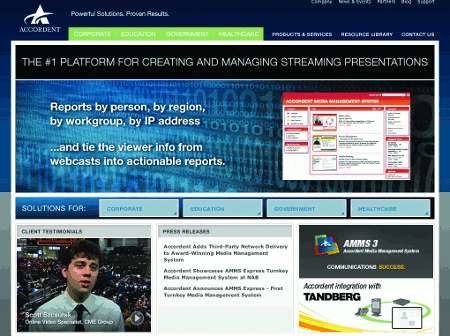Voyage of the DAMed
The Challenges of DAM
Cushman & Wakefield, Jensen’s company, is a New York-based real estate firm. While a neighborhood realtor has no use for DAM, Cushman & Wakefield is the largest privately held commercial real estate services firm in the world, with 13,000 employees spread over 231 offices in 58 countries. When the company resident makes an announcement, it reaches individuals from Moncton, Canada, to Hyderabad, India. Jensen oversees CWTV, an internal CDN that provides streaming video to all Cushman & Wakefield employees.
"It has been in existence approximately 2 years, and we deliver to anything from one person to 10,000 [people]," Jensen says. "Some of our 13,000 employees are on-site employees, which means they are actually housed within other corporations [and] can't get into the system."
The fact that some potential CWTV viewers were outside the company network, along with their geographic dispersal, eliminated the possibility of using an intranet to stream video. Jensen recruited Ignite when it became clear that bandwidth would be an issue. When 13,000 people all watch a video online, particularly a high-definition video, either streaming or downloading it eats up a tremendous amount of bandwidth.
 "If you think about a large enterprise that has a large number of locations," Janicki says, "each one of those locations has an internet pipe that comes out of it. That pipe goes back to the headquarters and to the data center." Essentially, if everyone at a given branch streams the video at the same time, it clogs up that pipe. But once the video gets inside the branch's LAN, bandwidth is not an issue.
"If you think about a large enterprise that has a large number of locations," Janicki says, "each one of those locations has an internet pipe that comes out of it. That pipe goes back to the headquarters and to the data center." Essentially, if everyone at a given branch streams the video at the same time, it clogs up that pipe. But once the video gets inside the branch's LAN, bandwidth is not an issue.
"Our challenge was that we had a less-than perfect bandwidth infrastructure in place for any large file distribution, so we were looking for a way to deliver video, for example, to our employees without suffering from bandwidth hogging," Jensen says.
A typical DAM system prevents this problem by downloading one copy of the video or other multimedia package to the branch, and instead of going out to the WAN and using up bandwidth to view it, users stream that video from inside the building on the LAN.
Managing this bandwidth issue is one of the biggest challenges to DAM companies today, but it is not the only one. Providing acceptable solutions to every client is another, as a one size- fits-all solution is not acceptable to companies with different needs.
"This is a unique solution for large organizations to roll out insofar as it touches a lot of different divisions, some of which are very familiar with evaluating and deploying technology, and others which are very focused on business objectives," Newman says.
Another obstacle on the horizon for DAM companies has to do with the evolution of corporate content management. At present, many companies go to different providers for their DAM, CMS, and social networking needs. In the coming years, this may not be the case.
"The integration between your digital asset management, your VCM [video content management], and your ECM [enterprise content management] is really vital," Deadrich says. "We're coming to this convergence point where people are starting to realize that what used to be in the archive world ... is now pushing more and more onto the website, now that bandwidth is lower and hosting is lower. It now becomes more transparent because you want to push that content public."
While such integration will take a great deal of cooperation and programming, it is the intuitive next step for the users.
"People don't want to go between five distinct bake-offs from 15 different vendors to provide what everyone agrees should be provided by one or two solutions," Newman says.
Due to the proliferation of online video and the demand for more DAM systems with more features and more customizability, the DAM industry is a growing one. Advances in broadband technology and the increasing acceptance of industry standards only stand to increase the rate of growth.
"It's essentially all good news," says Hood, whose company aims for 60% growth next year. "There're bandwidth improvements both behind the firewall and out on the internet. There's the adoption of things like H.264, which is becoming standard across use cases, which makes things easier."
Ultimately, DAM companies are banking on online video continuing to become cemented in the culture of communications, just as phones and email had in the generations before.
"I remember when email first came out, but a lot of people were extremely skeptical about it," Hood says. "At a critical point of adoption, email became an expectation of employees, particularly younger employees."
In all, the biggest challenge will be to keep providing a worthwhile product. For the executives writing the checks, investing in technology is only worth it if it helps the company run cheaper, smoother, and easier.
"Most senior executives are not necessarily enthralled by streaming or by webcasting," Newman says. "They're enthralled by the results."
Companies and Suppliers Mentioned